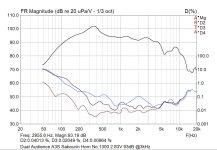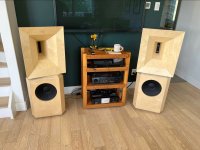The key points I see here are the at the horn area expansion is correct through the combiner, The bends of the combiner are minimised, the outer wall angle joins the main horn smoothly and from a point of simlar width to the throat. The inner wall angle is not straight. I designed the below combiner, it differs on many of these features and it dosen't perform as well:
A key parameter if you design these structures is how close you can pack the compresion drivers (much easier if they are smaller).
I guess bms coaxial and 12" is not possible without having a hole around 600hz, also would not be possible with even 10" because probably paraline almost long as 10" would not work so good.
What do you people think of a 4way synergy.
Dcx464 on a paraline, 2x 5" m5n8-80 (xo 900hz) on sides followed by 2x 12" 12fh520 (500hz).
I think those would be hard to put in 1/4wavelenght but may be possible.
And one question Does speakers driven lets say under 900hz and placed in 1/4 wavelenght couple 6db in all frequency or just some parts?
What do you people think of a 4way synergy.
Dcx464 on a paraline, 2x 5" m5n8-80 (xo 900hz) on sides followed by 2x 12" 12fh520 (500hz).
I think those would be hard to put in 1/4wavelenght but may be possible.
And one question Does speakers driven lets say under 900hz and placed in 1/4 wavelenght couple 6db in all frequency or just some parts?
Tagging on some things that @kipman725 wrote -
Joseph Crowe has an interesting article about using a pair of high quality full ranges loaded on a horn:
https://josephcrowe.com/blogs/news/dual-audience-a3s-fullrange-drivers-in-sabourin-horn-no-1303
Years and years ago, I built something similar using the Aurasound 2" drivers. It worked shockingly well. I actually shelved it because I thought I might be doing something incorrectly. As @Genuine noted, it was one of those projects where you're scratching your head trying to figure out why more companies don't do it.
Having built a lot of horns and waveguides, my guess is that these aren't common in prosound because their output levels are relatively limited. Also, prosound companies tend to offer "metoo" solutions, where you can get very similar speakers from half a dozen different companies. I think this is "a sales thing", basically the sales folks at these companies can't easily move a lot of speakers if they're really far out in leftfield.
These types of horn loaded full ranges solve a lot of problems, but they'll likely need a super tweeter to get them to play to 20khz. But the ability to generate 93dB from a pair of 75mm drivers is quite amazing.
Joseph Crowe has an interesting article about using a pair of high quality full ranges loaded on a horn:
https://josephcrowe.com/blogs/news/dual-audience-a3s-fullrange-drivers-in-sabourin-horn-no-1303
Years and years ago, I built something similar using the Aurasound 2" drivers. It worked shockingly well. I actually shelved it because I thought I might be doing something incorrectly. As @Genuine noted, it was one of those projects where you're scratching your head trying to figure out why more companies don't do it.
Having built a lot of horns and waveguides, my guess is that these aren't common in prosound because their output levels are relatively limited. Also, prosound companies tend to offer "metoo" solutions, where you can get very similar speakers from half a dozen different companies. I think this is "a sales thing", basically the sales folks at these companies can't easily move a lot of speakers if they're really far out in leftfield.
These types of horn loaded full ranges solve a lot of problems, but they'll likely need a super tweeter to get them to play to 20khz. But the ability to generate 93dB from a pair of 75mm drivers is quite amazing.
Attachments
Hi JLH,I decided to simulate the effect the passageway's acoustical size has on the wave propagation inside a paraline. I used Horn Response's wave front simulator. I modeled with two different frequencies (1KHz and 10KHz) and with, and without reflectors.
First picture is the paraline with reflectors. I removed the reflectors for the other set of simulations.
An externally hosted image should be here but it was not working when we last tested it.
The next pic is of a 1KHz frequency being played in the paraline with reflectors. As you'll notice the wave front flows around the bend without issue. It does this because the bend's acoustical dimensions are too small to have an effect.
An externally hosted image should be here but it was not working when we last tested it.
The next pic is the paraline without reflectors. Once again, due to the wave front being acoustically large, the bends are still invisible to it and have no impact.
An externally hosted image should be here but it was not working when we last tested it.
Now we bump up the frequency to 10KHz. We now start to see what happens when our wavelengths become short enough to "see" the acoustic image of the bends.
This next pic is the paraline with reflectors and a 10KHz signal being played. Look at how messed up the waves are. The size of this paraline is too large to support 10KHz. There is a lot of wave front discontinuity going on. However, we still get waves coming out of the mouth slot.
An externally hosted image should be here but it was not working when we last tested it.
Lastly, we have a paraline without reflectors playing a 10KHz signal. There is a lot of discontinuity just like the one with reflectors, however there is almost no output at the mouth slot. There is so much cancellation going on there is almost no waves making out the mouth slot.
An externally hosted image should be here but it was not working when we last tested it.
So, what does this tell us?
1.) If the passageways are sized to the correct dimensions for the highest frequency of interest, then there will not be problems with the bends.
2.) If you over size the passageway, you will get cancellations even with reflectors.
3.) At higher frequencies, having reflectors is better than not having them. I believe this is why you see Danley's paraline with reflectors.
I was reading through your comments, and unfortunately, the images aren't available anymore. Is it possible to share them again? Thanks
GQZ
Do you actually hear up that high? And secondly have you done an analysis of the music you listen to? My hearing poops just below 15k and I have regularly for 20 years watched a musical spectrum analyzer on Foobar as I listen, almost nothing above 14kiliohertz. The odd time on full orchestral. What you show here is a great idea. Leveraging the best that can be had from the system. Joseph is doing some more and more interesting work.Tagging on some things that @kipman725 wrote -
Joseph Crowe has an interesting article about using a pair of high quality full ranges loaded on a horn:
https://josephcrowe.com/blogs/news/dual-audience-a3s-fullrange-drivers-in-sabourin-horn-no-1303
Years and years ago, I built something similar using the Aurasound 2" drivers. It worked shockingly well. I actually shelved it because I thought I might be doing something incorrectly. As @Genuine noted, it was one of those projects where you're scratching your head trying to figure out why more companies don't do it.
Having built a lot of horns and waveguides, my guess is that these aren't common in prosound because their output levels are relatively limited. Also, prosound companies tend to offer "metoo" solutions, where you can get very similar speakers from half a dozen different companies. I think this is "a sales thing", basically the sales folks at these companies can't easily move a lot of speakers if they're really far out in leftfield.
These types of horn loaded full ranges solve a lot of problems, but they'll likely need a super tweeter to get them to play to 20khz. But the ability to generate 93dB from a pair of 75mm drivers is quite amazing.

